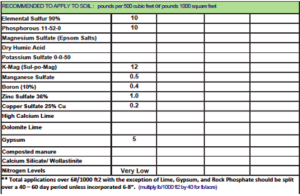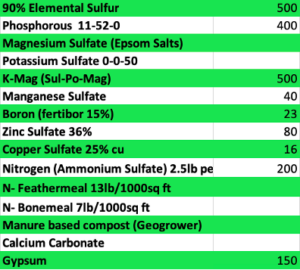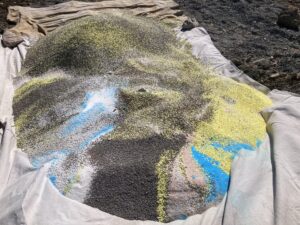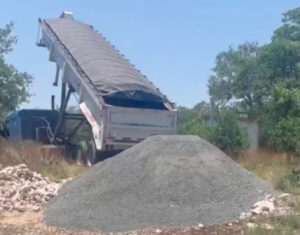“Fertilizer is too expensive, so we couldn’t buy it this year”:
“We have 70 acres in Central, Texas, and over the past 3 years fertilizer costs have gone way up. It was $3000, then $4500, then they wanted $9000 this year. At this point it isn’t worth fertilizing or irrigating.” -Anonymous farmer-
I have heard these exact words too many times this year, as this is the conversation that many farmers across the globe are having right now. As a design firm that focuses on Regenerative Agriculture in Central Texas, we at Symbiosis work with new and old landowners to address root cause solutions to this problem and others pertaining to water harvesting and nutrient cycling on properties of all sizes. What follows is our open-source approach to saving farms and farmers money while growing a more nutrient dense end product. If you are searching for this, then I will provide the short answer of “how” followed by the longer answer of “why” by following the embedded links to the many guiding heroes that have paved the way for us to follow. I believe it is essential to understand how soil and plants operate for the survival of any soil-based business and for our ability to live in right relation with the Earth for many healthy future generations to come. Six years ago, the United Nations’ Food and Agriculture Organization said soil degradation was proceeding at such a rate that the world may only have 60 harvests left, noting that it takes up to 1,000 years to build 3 inches of topsoil. What follows is how we all change that alarming sound byte and step forward with a cohesive plan and the courage to be the change in our community.
Nutrient dense crops grown in mineral balanced soils are disease suppressive and are not impacted by insects. Insects operate as the lions of the plant world, culling the sick and old plants which are only able to make simple sugars and unable to convert them into more complex amino acids, proteins and lipid fats that benefit human health. When plants are strong, they produce complex components which the simple gut of an insect cannot digest and they are not able to be preyed upon, thus saving the use and cost of pesticide and fungicides. Nutrient dense food dehydrates instead of molds and are not only a better tasting product that nourish those who consume them, but a product that lasts longer on the counter with a greater shelf and storage life.
https://regenerativeagriculturepodcast.com/developing-disease-suppressive-soil-with-jill-clapperton
Weeds grow where conditions out of balance or compacted causing a climate conducive for them to grow. They seek to balance soils by bringing up minerals from the deeper soils and depositing them on the surface in the form of biomass and leaf litter. So, to balance your soil is to limit the need for herbicides. As a solution to decreasing external diversity killing inputs (herbicide, fungicide, pesticide) and allowing greater profits and human and ecosystem health lets lay down the system that we use to address these issues.
Before ever applying more Nitrogen, Phosphorous, and Potassium (N-P-K) we must know and respect the biochemical sequence as discovered by the late great Hugh Lovel.
“What is the hierarchy or ‘biochemical sequence’ of what must function first before the next thing and the next thing works. The elements early in this sequence must be present and working well before later elements have any chance of being useful for plant growth. Nitrogen, phosphorous and potassium occur late in this biochemical sequence, while Sulphur, boron, silicon and calcium start things off… Unfortunately for nutrition, health and long-term vitality of the soil’s biochemistry, soluble NPK fertilizers continue to be used for their ability to gloss over deficiencies of Sulphur, boron, silicon and calcium. Large reserves of nitrogen, as well as phosphorous and potassium, are commonly present—even if inactive—at the surfaces of soil particles where the organization of life chemistry arises. Only when the biochemistry of Sulphur, boron, silicon and calcium is thriving can the potential of these reserves become available.”
Step 1: Acknowledge that soil follows a chain of chemistry where one mineral affects the plant’s ability to uptake and then use the next or you will experience bottlenecks and fertilizer leaching if all links of that chain are not available in working order. That order being:
- Sulphur which dissolves the edges, creating more surface area for biology and chemistry to interact
- Boron, which activates and increases sap pressure of the plant
- Silicon, which carries all other nutrients, building strong cell walls and an effective transport system starting with
- Calcium, which binds and shuttles nutrients across cell membranes starting with
- Nitrogen to form amino acids, DNA and cell division. Amino acids form proteins such as chlorophyll and tag trace elements, especially
- Magnesium, which is at the heart of chlorophyll that transfers energy via
- Phosphorus in the form of ATP and allow energy to move in the plant to
- Carbon to form sugars, which go where
- Potassium carries them.
This is the basis of plant growth, simplified yes but an effective model to work with
https://quantumagriculture.com/2016/04/27/the-biochemical-sequence/
Step 2: Take a soil test that measures all of these in addition to trace elements.
We like to work with Logan labs and understand their format, but many others are out there. We use their:
- Complete test with Extras which includes a Soil Paste test
- Check the box for Recommendations from Bill McKibben
Submitting Soil reports:
https://loganlabs.com/get-started.html
Background on Bill McKibben:
https://www.youtube.com/watch?v=sGK9ClROJmE
We are aware of the Haney soil test and appreciate its holistic view of the soil and highly encourage its use to establish a broad baseline of data and it’s always helpful to get a different perspective. The Haney test, in short, acknowledges the weakness in Complete tests that measure nitrogen in dry soil samples only and leave out the fact that about half the nitrogen available to plants exists in the solution of water. This is a great assessment system to include, yet in our experience we find that it typically indicates that we could use half as much nitrogen as suggested by other test which keeps it simple for us.
https://regenerativeagriculturepodcast.com/updating-soil-analysis-to-consider-microbial-influence-with-rick-haney
We are firm believers in gathering as much data as you can, in addition to opinions of peers, then stepping back from it all and using your own experience and intuition to navigate a middle path through it all that works for you and your holistic context and long-term goals. We are, in the end, painting landscapes with minerals which are the building blocks of life, so there is room for creativity and awe in the life processes that we are co-creating with.
Step 3: Results and calculating materials
You will receive three documents in an email from Logan Labs
- Complete test – as dissolved with strong acids
- Paste test – as dissolved with water
- Recommendations – this is the most user-friendly document, and it looks like this:

One of the important pieces of all this is the line on page two “pounds per 1000 sq ft x 40 equals pounds per acre.” For this particular site we would be using a cone seeder to distribute minerals on 2 acres. Another useful piece of information is at the bottom of page one, “Total application over 6#/1000 sq ft with the exception of lime, gypsum, and rock phosphate should be split over a 40-60 day period”
There are, after all, maximum limits of how much can be incorporated and benefit life before it becomes a toxic load that inhibits life. As stated by Dan Kittredge, “don’t follow the Moron rule, thinking that if a little is good, then putting more on must be better.”
For more-on Dan Kittredge and his work with the Bionutrient Association:
https://www.youtube.com/watch?v=im42xjLEk3A
Lets begin with Sulphur for example: From the soil recommendations above,
10lbs: we limit that at 6lbs now and 4lbs later per 1000 sq ft, 6lb x 40 = 240lbs per acre x 2 acres = 480 lbs Sulphur needed now. And we end up with and order list that looks like this:

Step 4: Ordering
We use Earthwise Organics, but whichever product provider is closest to you with a quality product would be the best to save on shipping. https://earthwiseagriculture.net/
A few suggestions from the Bionutrient Food association are here:
https://bionutrient.net/site/growers/amendment-suppliers
Send the order request, then adjust the order cost with the knowledge of the Biochemical Sequence. I will keep 100% of the recommended Sulphur, Boron, Silica, and Calcium and cut back the others by whatever percentage is needed to make it affordable as there are likely rich reserves in the soil that will mobilize once the weak links have been replaced. The best source of silica is in basalt “fines” from the most local quarry to you. We purchased 25 tons of basalt fines ¾” and smaller for $10 per ton. Including shipping from the Knippa, Tx mine it cost us $1200 for this 2 acre project. Locate a 20-25 ton semitruck hauler near the mine and place your order. Make sure that your site access and low hanging trees can handle the size of truck that you order! https://www.vulcanmaterials.com/construction-materials/facilities/knippa-trap-rock
Rock dust as described by the Bionutrient Food Association “These materials generally contain on the order of 25-45 minerals each and are available at quarries as “fines” or “float” for $4-8 per ton. Our general recommendation is that an application of up to 10 tons per acre of a material such as this would consist of a systemic remineralization.” https://bionutrient.net/site/growers/basic-protocols


Step 5: Distribution
These are all salts that are activated with any moisture, so please wear long sleeves, gloves, a respirator and protective eye wear when mixing these. A safer but more costly alternative than mixing them yourself is to ship them directly to a soil yard to have them use their loaders to incorporate the minerals into a load of compost. This stabilizes the salts with carbon and life forms but this necessitates using a compost spreader to disperse. Each choice has its own risk and benefit. If using a cone seeder, you will need a calm day so that the finer materials like boron are not blown around before they reach the ground and you will need to wear appropriate personal protective equipment. That goes for spreading the basalt dust too. Silica is great for unlocking the potential of plants in soils but very bad to breathe into your lungs.
Step 6: Seeds
Cover crop, a mixed variety of natives wildflower seed and cool or warm season appropriate to the time of year that are inoculated with mycorrhizae will be your best tool to bring up minerals from the deep soils and incorporate all these new minerals into the soil.
For this particular project the goal was to increase biodiversity so we utilized all the appropriate mixes from https://www.seedsource.com/ They are a wealth of information and I highly recommend calling them and having a conversation about your needs, goals and financial parameters. We combine these with the wider and faster growing diversity of cover crops from https://greencover.com/webinars/ Another incredible resource for the grower. https://greencover.com/webinars/
To review:
If I had the smallest budget possible, I would prioritize Sulphur, Boron, Basalt rock dust for its silica, mixed mineral content, paramagnetism, and Calcium. A word on that by Phil Callahan,
“We may understand then that there are three ways to generate this valuable magnetic force called paramagnetism into the soil:
- By adding volcanic rock into the soil,
- By fiberization so that paramagnetic oxygen reaches the roots in soggy soils
- By using weeds, which are green containers of paramagnetic minerals, in our compost”
https://bookstore.acresusa.com/products/paramagnetism
For more on Calcium’s role as the “king of nutrients” and great shuttle of nutrients and a holistic view of life and energy in soil please enjoy Arden Andersen’s books and podcast https://bookstore.acresusa.com/products/anatomy-of-life-and-energy-in-agriculture?_pos=9&_sid=7553ddf8b&_ss=r
https://regenerativeagriculturepodcast.com/biophysics-of-soil-plant-systems-with-arden-andersen
The first three create a strong transport system in the plant, Sulphur dissolves the edges and allows more surface area for biochemical reactions to occur, Boron for increased sap pressure to get sap from root to the tip of the shoots of growing plants, Silica for strong cell walls like rebar for concrete buildings allowing plants to grow tall and strong to contain all that sap pressure, then Calcium as the bus that drives all nutrients across cell membranes. Mix these into a small batch of compost, more for the Carbon and life forms than the Nitrogen and Phosphorous. Then add seed or cover crop appropriate for your context and inoculated with Biocoat gold from the good people of Advancing Eco Agriculture https://www.youtube.com/watch?v=jjtthmItd4U
The final tool that I try to add to any and all projects is the Biodynamic Buffalo Soil Activator
https://www.biodynamicsource.org/buffalo-soil-activator.html It is created with a great honoring and reverence for the relationship that the American Bison has had with the building of soil over time. It is a very user-friendly way into biodynamics and only needs to be stirred for 1 minute before either adding to seeds as an inoculant or spraying on its own out on the land in the evening. I see Biodynamics as the formative forces that encourage all things to move.
If balanced minerals, bacteria, beneficial fungi, and a diversity of seed are all the people invited to the party, then Biodynamic preparations are the food, music, reason, and adult beverages that provide the social lubrication for great conversation, comingling, and excitation of elements. Imagine all those elements standing around a dance floor eagerly awaiting their favorite band to start playing. Sure you may have that rogue element or two start to dance before the music arrives but once it starts and the dance floor becomes a buzz of activity. That buzz is the stable and living, vibratory, colloid that we are striving for a soil to become. Elements are no longer soluble because they are attached to another dance partner, and yet they are available to intermingle and be interchangeable depending on how the conditions change throughout the evening. In my personal opinion and experiences biodynamics have brought a palpable and sensible change in the atmosphere when used even in small amount, I can only explain it as if the music is playing, then people will find their way to the party even if they come from far away to join.
For an overview of natural farming techniques that are cheap and effective methods used around the globe for those still hungry for more and how to layer and integrate multiple methods are the Three Pillars of Eco-agriculture from the agronomist Steve Diver https://www.youtube.com/watch?v=91JaF4zcTAQ
The above was and will remain our method for jump starting land regeneration. The cherry on top and the real long-term solution is animal impact appropriately grazed using methods of the Savory Institute. https://savory.shop/ which allows the animal to do the work of digesting mineral rich weeds and redistributing them. If you are utilizing animals then providing a free choice mineral option to allow them to thrive as well as distribute those minerals which they sense are deficient.
We are all stewards of this great spaceship Earth, spinning at great speeds through an unknowably large cosmos and we are just now learning how our soils truly operate so that we may mend them when they have been injured by our past actions based on incomplete knowledge. This is truly humbling and can be an overwhelming practice for those working with soil because we first must become a technician of the Earth and how her elements and players function together before we can responsibly tinker with the parts to move a system in the direction we desire given our own personal holistic context.
Learn as much as you can, pick up the phone and call these resources, read books then call or email the author with your questions, make a plan, fail forward on small experimental plots, celebrate your successes, share your failures with others as they are great learnings to build comradery with your neighbors so that you can all grow together as a community once again.
This may be new information to you so give yourself time to assimilate and reflect on these ideas. Be cautious of sales agents using fear of crop failure into selling you something and seek out counsel in those that are seeking the truth in how these wonderous and complex systems work to grow the most nourishing, healing, and profitable foods as possible.
In the near future the farmer and the consumer will have access to the Bionutrient Meter which is a first-of-its-kind handheld spectrometer to measure the nutrient density in food and crops, and the carbon in the soil. This will allow us to move past labels and quantify which food and methods grow a more nutrient dense crop. https://www.youtube.com/watch?v=AmmVZdrfSvA
We wish you the very best and please feel free to share feedback as we are learning as fast as we can every day and welcome all the thoughts of our peers in this great Earth repair journey.
Author: Adam Russell



